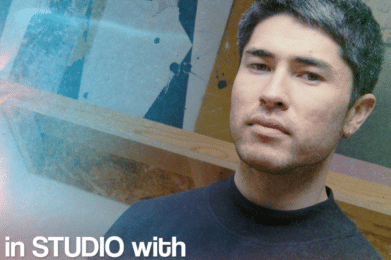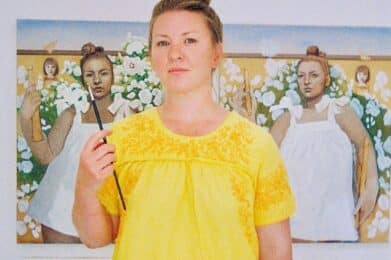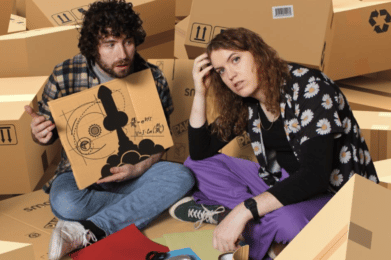Interview with Gerard Byrne “When I look back at the early days of my career, those hard times were precious. They made me who I am today.”
Gerard Byrne, a Dublin native and one of Ireland’s well-known contemporary artists. He is recognised for his vivid plein air works and figurative paintings, and he has established a comfortable gallery and studio in the heart of Ranelagh. We are delighted to chat with Gerard about his work and his recently published book “Turning Corners“.

You’ve been painting throughout the pandemic, and you’ve chronicled it so well through your artworks. How did you select the paintings that made it into the book?
Every painting I produced during the three lockdown periods is included in Turning Corners. All 150 of them. Originally, I felt it might be too much to include them all. I was conscious that several of the works are very similar – the same scene painted from different viewpoints or at various times of the day for instance. But each painting has its own unique story, its own place within the context of my lockdown journey: the people I met while I was painting it, the weather on the day, the atmosphere, my own thoughts etc. When I look at each one, I remember those moments. The book is a visual journal of a specific and significant time, so it wouldn’t be truly representative of the period if any painting had been left out.
It’s obviously much different painting in 2020 compared to this summer. What are some differences you’ve noticed yourself from the process?
During lockdown, people were more curious. They had more time to stop and talk, to ask questions, to engage with me. I think they were almost looking for distraction, for entertainment, and they seemed to really appreciate seeing me out painting. It touched a nerve; it meant something to them, and they were outspoken in letting me know. Now, it’s very much back to business, to normality. People don’t have the time, or the need. The public still engages with me when I’m out painting but not at all to the same extent. Not that I’ve had much time to paint this summer, to be honest. After the huge output of lockdown, I needed a bit of a break. The weather wasn’t great at times either. I had a few commissions to complete in Dingle but every time I wanted to go the forecast was for stormy, wet conditions. Also, a massive amount of work went into the production of the book, so that’s where the focus was this year.

Once the lockdowns eased up, did you have the urge to travel further for locations? Have you done any international work since 2020?
Once the lockdown was over, I wanted to run away – like a lot of people in the country, I think. It wasn’t as easy as that though. It was expensive, there were problems at the airport, massive queues, luggage going missing and so on. When I go abroad to paint, I take a lot of equipment with me, a lot of excess luggage. I didn’t want to head off somewhere and then find my easel or my canvases hadn’t arrived. Also, we – myself and my wife, Agata – had been working flat out throughout the pandemic to keep the business going. Because the Gallery was closed, we focused a lot of time on the website, on social media, virtual tours, and online exhibitions etc. And, of course, the book. When travel was possible again, our minds weren’t really focused on ‘what’s next?’ or ‘where next?’. What we needed was to recharge the batteries, take a deep breath after the frantic pace of the previous two years. We took the month of August off this year to do just that.
How was the process of making the book? Was there something about this body of work that seemed especially suited to a book format?
My output was huge during lockdown. The Gallery was closed so I had accumulated a very large amount of work. Agata has had, for quite some time, the idea of producing a coffee table type book of my work, perhaps to document my thirty-year career. But when the pandemic happened, and I had this explosion of creativity, it seemed that here we had a body of work that could, in effect, frame this hugely significant period in our history. It felt like the right time to do it, for now and for future generations.
Having continued to such a positive proactive approach during the global crisis, do you have advice for artists who may be struggling through difficult circumstances?
Don’t expect it to be easy. Be true to what you want to do. Try and enjoy the pain. Accept that this is the way it’s supposed to be. I have been a full time artist for over thirty years. I did the starving artist bit in New York when I had absolutely no money, and in Berlin in the late 1980s when the Wall was coming down. I painted through the recession. Being an artist is always a struggle. Making that choice is never an easy thing to do. If it was, we’d all be doing it. But when I look back at the early days of my career, those hard times were precious. They made me who I am today. I chose to be an artist not thinking about how I could pay my bills. I just knew I wanted to do it and that if I paid my bills, that would be a bonus. I met some good people along the way, people who recognised my intent, my ambition. Those are the people who will help you and support you. We have a short life and a certain time to live it. You can spend that time doing a job you hate but it’s better to do the best you can with the time you have. That’s the decision I made, and it worked for me. I reckon I’m the luckiest person going, in that sense.

Hopefully you still have the opportunity to paint the cherry blossoms of Japan. After this exhibition, do you have plans for 2023 and beyond?
I have lots of ambitions. Lots of dreams. Since my show in Singapore (Byrne was Artist-in-Residence at the Singapore Botanic Gardens in 2019) I’ve been looking more towards international exposure. I feel I’d be ready for Japan. Before Covid, I was making plans like nobody’s business, looking to the future. But the pandemic taught me a lesson: don’t make plans, just do it. I’d like to go to the States to paint the fall. I did it before and would like to do it again. I saw Boston for the first time this year and I’d like to go back and paint the streets, the architecture. I’d also like to go back to Paris to paint. I’ve got lots of ideas: painting in different climates, different lights. I’m open to opportunities and I’m hoping Turning Corners will be a gate-opener, that the opportunities will seek me out. I’m ready for the challenge and I’m looking forward to it.
Anything else you like to mention?
We are living in strange times. We’ve gone from Covid to war, to energy shortages, accommodation crises and so on. The news always seems to be bad. It plays on the subconscious. It’s doom and gloom, we’re heading into the winter etc. So, I’d like to think that this exhibition will, in some way, alleviate those stresses and strains, that it will allow people to relax, to escape from the outside world, so to speak. We have opened another room to accommodate over 60 paintings on show and it’s not often people can see such a large body of work by one artist under one roof in a private gallery. The general feedback from visitors has been that they have really enjoyed the ambience, the tranquility that comes through the work, the colour, the warmth, the escapism.
Turning Corners exhibition continues at Gerard Byrne Studio until 23rd of October 2022.
Turning Corners book is available to purchase in the gallery and online at gerardbyrneartist.com.
We ship worldwide
To contact or learn more about Gerard Byrne’s work follow him on social media and check his website:
website: Gerard Byrne
Instagram: @gerard_byrne_artist
Twitter: @gbyrneartist
Facebook: @Gerard Byrne Artist
Linkedin: Gerard Byrne

























![Conversation with Maser: “I found graffiti definitely was the vehicle for me to be able to really explore what I wanted to do, meet similar peers that had the same sort of mindset as me […]”](https://dublinartlife.com/wp-content/uploads/2022/09/DAL-Interview-4-391x260.png)






